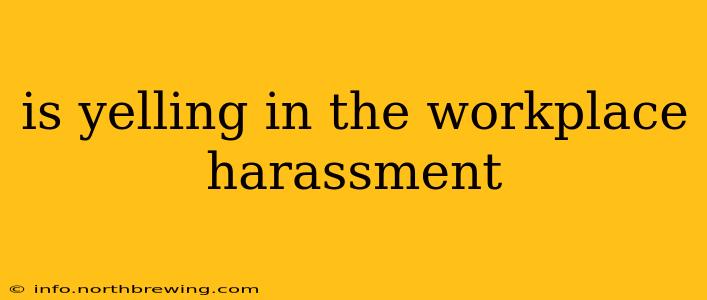Yelling in the workplace is a complex issue, and whether or not it constitutes harassment depends on several factors. While a single instance of raised voices might not be harassment, a pattern of aggressive or intimidating shouting can certainly create a hostile work environment. This comprehensive guide will delve into the nuances of this issue, exploring the legal definitions, identifying key factors, and providing guidance on how to address this problematic behavior.
What is Workplace Harassment?
Workplace harassment encompasses any behavior that creates a hostile, offensive, or intimidating environment. This can include verbal, nonverbal, or physical actions that are unwelcome and affect an individual's ability to perform their job. It's crucial to understand that harassment isn't just about severe actions; it can also be a pattern of less intense but still damaging behaviors.
Is Yelling Always Harassment?
No, yelling isn't always harassment. A one-time raised voice during a stressful situation, for instance, might not be considered harassment. However, the context matters significantly. Consider these factors:
-
Frequency: Repeated yelling is a major red flag. If someone is regularly subjected to shouting, it creates a climate of fear and intimidation.
-
Intensity: The volume and tone of voice play crucial roles. A sharp, angry yell is far more likely to be considered harassment than a brief, concerned exclamation.
-
Target: Is the yelling directed at a specific individual or group? Targeted yelling can be a form of bullying and is often considered harassment.
-
Intent: While difficult to prove, the intent behind the yelling is relevant. Was it intended to intimidate, humiliate, or threaten?
-
Impact: The most crucial factor is the impact on the recipient. Does the yelling cause emotional distress, anxiety, fear, or affect their job performance? Even if unintentional, the impact on the recipient can justify a harassment claim.
What if the Yelling is from a Supervisor?
Yelling from a supervisor carries extra weight. Supervisors hold a position of power, and their actions have a greater potential to create a hostile work environment. Supervisory yelling can be a form of abuse of power and is often more readily considered harassment.
How to Address Yelling in the Workplace
If you're experiencing yelling in the workplace, take these steps:
-
Document Everything: Keep a detailed record of each incident, including the date, time, location, individuals involved, and a description of the event. Note any witnesses.
-
Speak to the Person Directly: If you feel safe doing so, consider speaking to the person yelling. Explain how their behavior affects you and request that they stop.
-
Report to HR: If direct communication doesn't resolve the issue, report the behavior to your Human Resources department. They are responsible for investigating complaints of harassment.
-
Seek Legal Advice: If the yelling continues despite reporting it, or if the situation is severe, you may wish to consult an employment lawyer.
What if the Yelling is Part of the Job?
Certain jobs, like emergency services or construction, may involve shouting as a necessary part of communication. However, even in these contexts, excessive or abusive yelling can still be considered harassment. The key is to differentiate between necessary vocal communication and intimidating or abusive shouting.
What are the Legal Consequences of Workplace Yelling?
Depending on the severity and frequency, workplace yelling can lead to legal repercussions. Companies can face lawsuits for creating a hostile work environment, and individuals can be disciplined or terminated.
Can Yelling Be Considered Bullying?
Yes, yelling can definitely be a form of bullying, particularly when it's targeted, repetitive, and intended to intimidate or humiliate. Bullying in the workplace is a serious issue with significant legal and ethical ramifications.
In conclusion, while not every instance of yelling constitutes harassment, repeated, intense, or targeted yelling can create a hostile work environment and is often considered harassment. It's essential to understand the context and impact of the yelling to determine whether it crosses the line into unacceptable behavior. Always prioritize your well-being and seek appropriate action to address the situation.
